Busy as a bee at work…
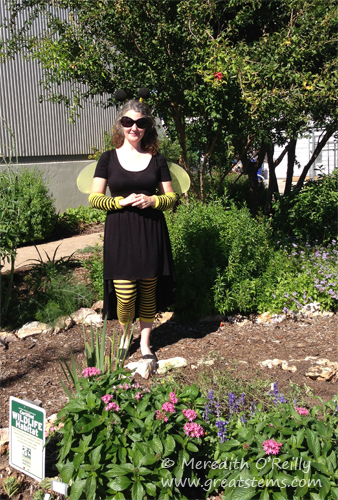
 I guess if you’ve gotta bee at work and bee bzzzzy, you might as well bee a bee doing it! (Halloween helps.)
I guess if you’ve gotta bee at work and bee bzzzzy, you might as well bee a bee doing it! (Halloween helps.)
Busy as a bee at work…

 I guess if you’ve gotta bee at work and bee bzzzzy, you might as well bee a bee doing it! (Halloween helps.)
I guess if you’ve gotta bee at work and bee bzzzzy, you might as well bee a bee doing it! (Halloween helps.)
Let me start by saying that we are still in a drought here in Central Texas. But tonight we’ve been experiencing another round of flash flood-producing heavy rains, a product of the particular weather systems and geography of the area. While folks in low areas face dangerous rising waters regularly (when there actually is rain, mind you), we’ve been fortunate to live in a house that really hasn’t had a problem, knock on wood. However, with the clouds dumping inches of rain in mere minutes — after having a few substantial rains over the past few weeks — for the first time in the 18 years we’ve been in this house, our house is in danger of flooding.
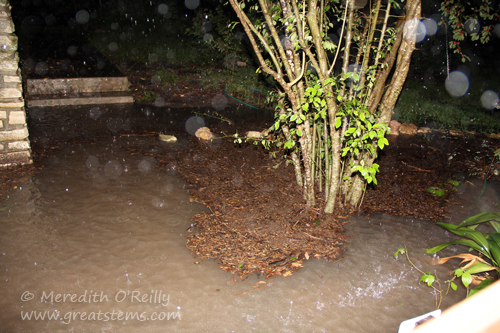
That’s the front of the house.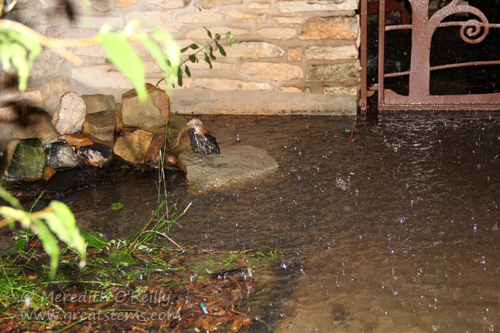
The entryway pond is underwater, too. Good thing we don’t keep fish in that particular pond.
I don’t think we’ll flood — the slope of the land sends most of the water toward the backyard. I’m worried about our neighbors, however, and I’m a little worried that I’ll have new trenches washed out in the back. I know many low-water crossings are deep in water, so hopefully other folks are driving safe. Tomorrow morning will be interesting!
Edit: Our garden rain gauge stops measuring at 5 inches, but our closest two “official” rain gauges in the city report that we’ve had 6-7.5 inches of rain in the past 12 hours, much of which was dumped all at once. I hear rain still outside, with more storms on the radar. It’s both wonderful to have all this rain and so interesting that for once our NW part of Austin is getting serious flooding. Usually central and south Austin spots get that main experience. I sure hope this means that Lake Travis is rising — it’s been depressing how low it has been during the drought.
As the sun peeked up over the trees this morning, I stepped outside to take delight in the dew-covered garden. The rains this fall have brought about a colorful wave of blooms and greenery.
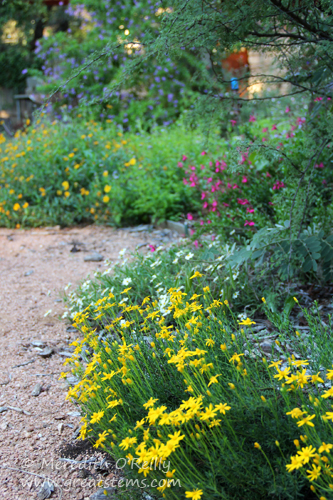
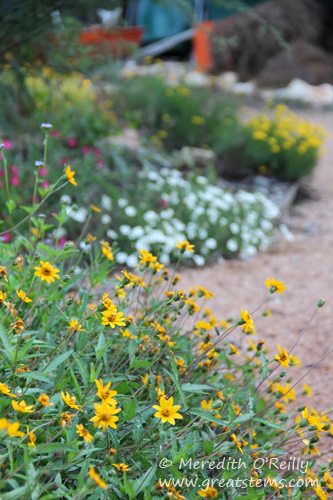
It might not look like it, but this area of my garden gets the worst of the summer sun, with rarely any water from me. This is why I love native Texas plants! They know how to conserve their energy in the summer heat. Then when fall rains come around, they perk up and smile (well, bloom).
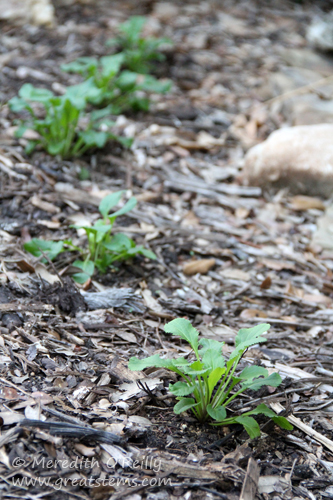
In fact, it’s Texas Native Plant Week right now (October 20-26, 2013). I started the week by getting the rest of my natives planted in the ground, all purchased from the fall Wildflower Plant Sale. I’ve been adding new species to further increase the biodiversity, including Chickasaw Plum, Wild Blue Indigo, Cardinal Catchfly, Foothill Beargrass, Paleleaf Yucca, Green Sotol, Desert Honeysuckle, and others. Above, I’ve planted more Golden Groundsel, a favorite.
The rest of the week, I’ve been helping get lots of native plants to schools in the Austin area. The students are learning about natives such as Flame Acanthus, Skeletonleaf Goldeneye, Purple Coneflower, Shrubby Boneset, Engelmann’s Daisy, and many more. They are also learning about why all these plants are so important for wildlife and for Texas.
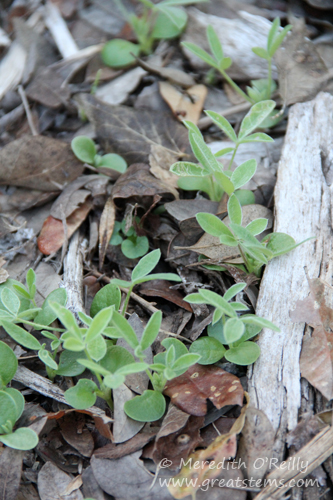
I’ve been spreading the Bluebonnet love, too. So many seedlings are cropping up this fall, far too many for my garden. I’ve given away more than a hundred little transplants already, and I’m helping others give away their excess seedlings, too. The 2nd graders I’m working with absolutely loved planting a bluebonnet garden at their school.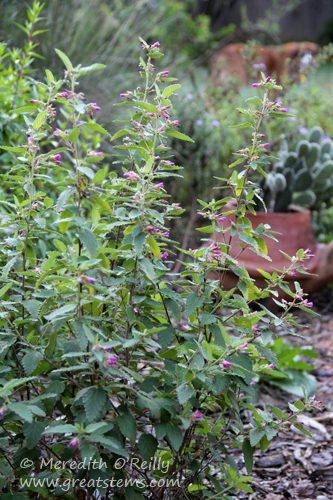
One of my favorite native plants is Pyramid Bush (Melochia tomentosa), a sweet little shrub I purchased at the Wildflower Center last year. In the early morning, the flowers are all closed up.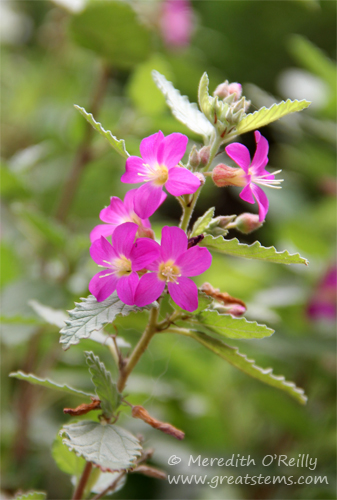
But in the warmth of the day, the blooms open, proving a touch of pink to the garden.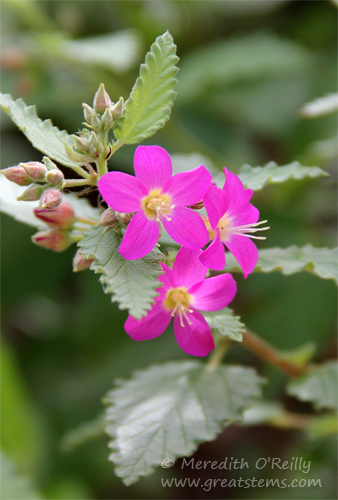
Don’t let the dainty flowers fool you — this plant is a hardy survivor, taking on the full summer sun without needing much water.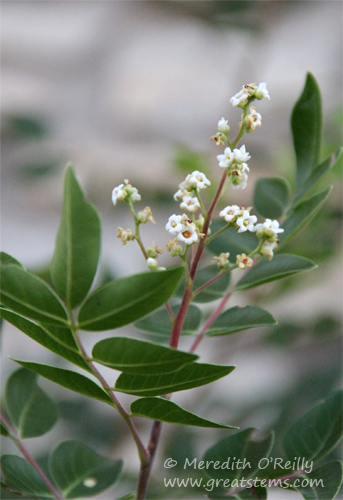
Elsewhere on our property, the Evergreen Sumacs are in bloom. Berries will soon follow.
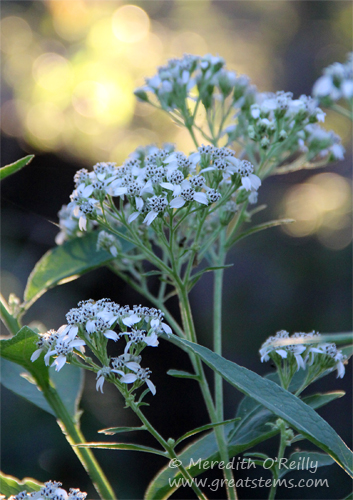
The Frostweed is tall and in full bloom, too, looking extra lovely when backlit by the morning sun.
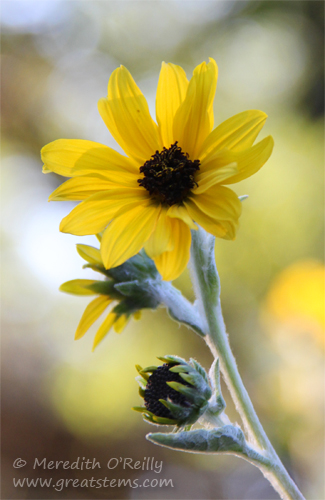
The sun’s early morning lighting also highlighted another tall flower, a Silverleaf Sunflower.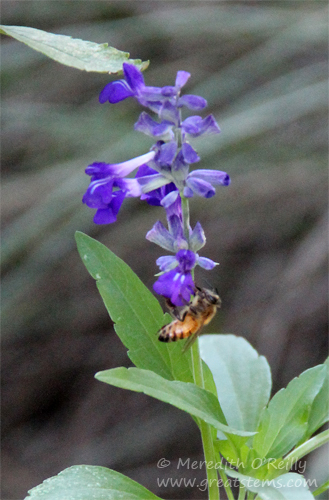
This little honeybee was the first pollinator of the cool, early morning. First come, first served! Clever little bee… or at least a very hard worker.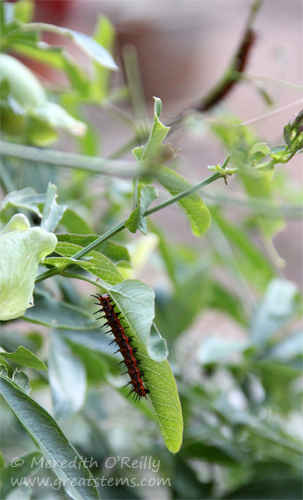
The Gulf Fritillary caterpillars are hungrily eating up the Passionvine. We have chrysalises all over the stone on the back of the house, and more can be found on vines, trellises, and trees. I’ve been providing caterpillars to the school teams I’m working with. It’s nice to be able to share this amazing life cycle. At the rate they are going, though, my vine is going to be a skeleton before long. But that’s how the cycle goes — it will be bigger than ever next year.
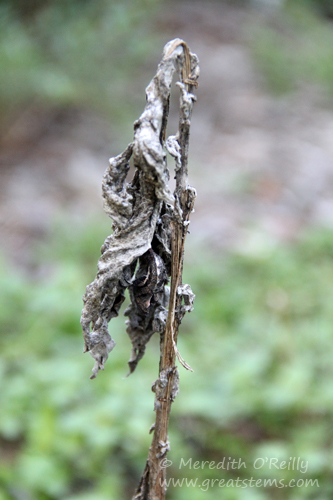
Surprisingly, one caterpillar wandered all the way to the front yard before making its “J” and chrysalis. Of all things, it chose a dead little sunflower as its chrysalis spot. Lucky for it, I noticed it while planting and weeding — I almost yanked the plant away! But I left the caterpillar and the plant, and by next morning, there was the chrysalis. Do you see it in the image above?
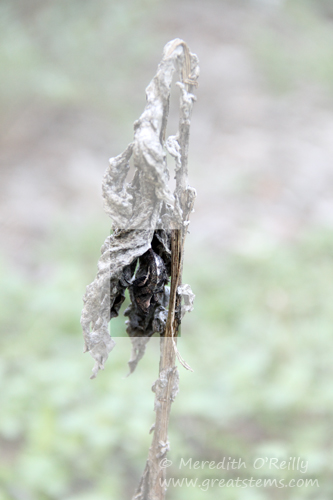
There it is!
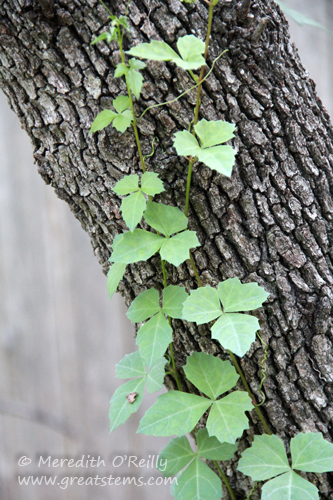
Way back in the backyard, a Cow-itch Vine (Cissus trifoliata) is growing, presumably planted by some bird. While I’m neutral about the vine in general, it turns out that it is the host plant for a couple of special moths found here in Texas, including the Vine Sphinx Moth and Wilson’s Wood-nymph Moth. So of course, I’m letting it stay.
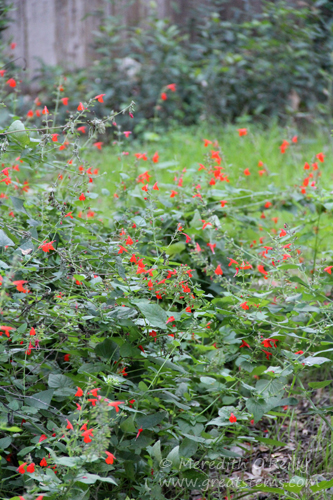
Nearby, Tropical Sage (Salvia coccinea) is king of the woodland area, being allowed to reseed freely. The hummingbirds love this area.
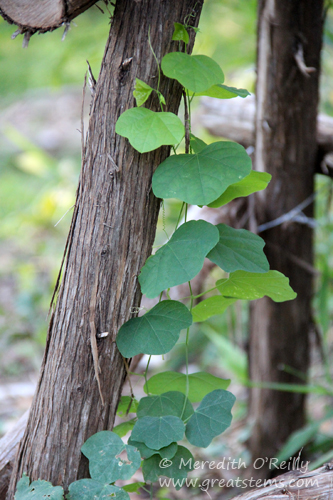
Under other shady trees, I was pleased to see that the Yellow Passionflower (Passiflora lutea) has finally found the cedar trellis we made for it.
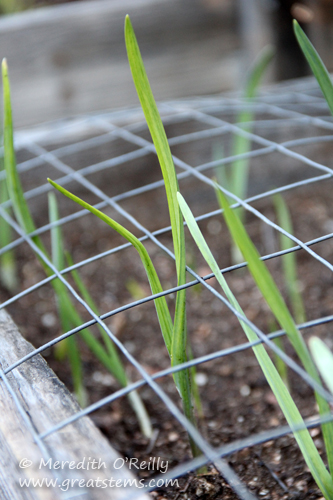
Not to be outdone by the natives, the veggie garden is looking great, too. Fall is so very much my favorite time to plant in Texas. We’ve had to cage a few newly seeded areas, as some nocturnal culprit has been digging into the beds a bit. Luckily, the garlic above does not find a cage an obstacle. This year’s garden includes cauliflower, broccoli, kohlrabi, garlic, shallots, snap peas, strawberries, lettuce, kale, spinach, and carrots, as well as many, many herbs. Loving it.
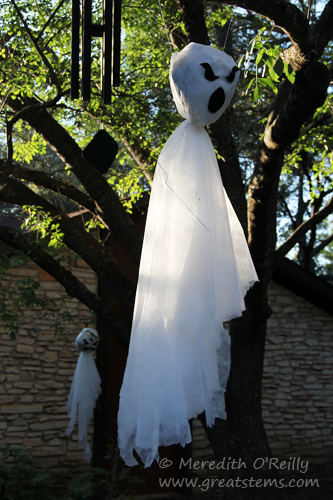 .
.
An error in measuring out garden fabric for one of the veggie beds proved to be a timely mistake. We turned our boo-boo into ghostly decorations. Boo! Boo! Get it?
Wonderful fall. Happy gardener.
All the rain we’ve been having lately has brought opportunities to see a huge variety of mushrooms all over the property, in all sizes, shapes, and colors. I love mushrooms. I see them as a sign of a functioning ecosystem and good soil.
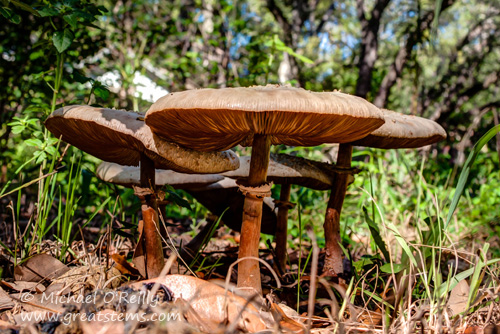
Back in the wooded area near where we hope to build our new shed soon (and I actually mean soon), we were wowed by almost a dozen giant toadstools dotting the ground. They were huge, about the size of my husband’s hand. Definitely “wow” fungi, I have to say.
We’ve had even more rain this week. Now I’m noticing other fungi but the toadstools have gone. Fascinating how mushrooms come and go — you never know what species will pop up next.
In a moment of pure golden brilliance, I came up with the idea of using eye stickers to turn kids into 8-eyed spiders when I’m teaching about our arachnid friends. Stickers in hand, I asked my teenage son if he’d be willing to be my guinea pig and then (I was holding my breath when I asked this) let me post his picture on my blog. He said sure.

This, my friends, is one of the many reasons why I love my son so, for not every teen would be so willing to do this. Our very own Spiderman, he is. And don’t you dare do a glasses crack and point out that some would say he looks more like a 10-eyed spider. What he is representing is a nearsighted 8-eyed spider. Gosh.
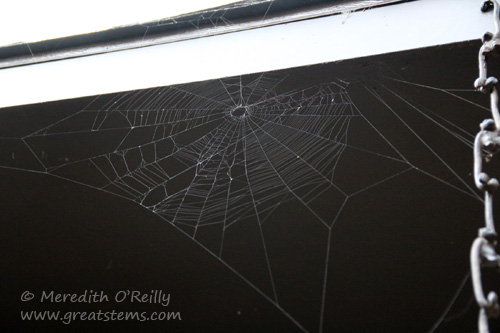
We looked up during our photo op and saw a huge and very well-placed orbweaver web hanging from the eaves way above us. It’s a sign, I tell you. The spiders approve.
We love our rain gauge, especially when it actually gets to do its job.
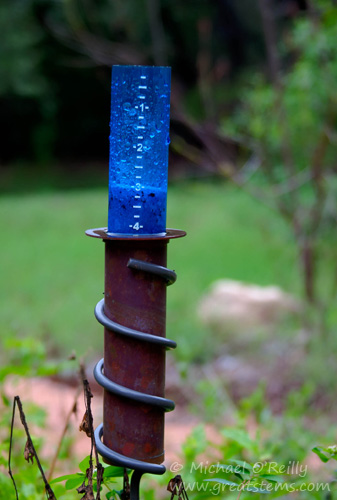
Welcome, rain! Please visit more often.
We’re up to somewhere between a dozen and 15 hummingbirds at the feeders now. I’m not sure whether our resident hummers are still here, but the rest are certainly in migration from up north and are gathering energy for their trip farther south and soon thereafter across the Gulf of Mexico. The birds are starting to share the feeders more and more, mostly because there are so many hummers now that individuals don’t really have a chance to defend their territory.
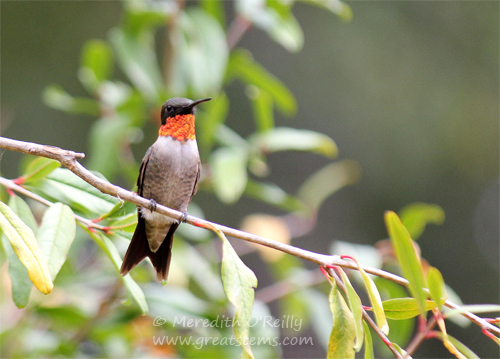
I know I have taken (and shared) lots of hummingbird pictures in the past, but it’s hard not to — the birds beckon me with their spirited antics, and I enjoy sitting out there absorbing their happy, frenzied presence. But if I find myself outside without my camera, I long for it, so mostly I just bring it along and try to get a great shot. Then, of course, I feel obligated to share.
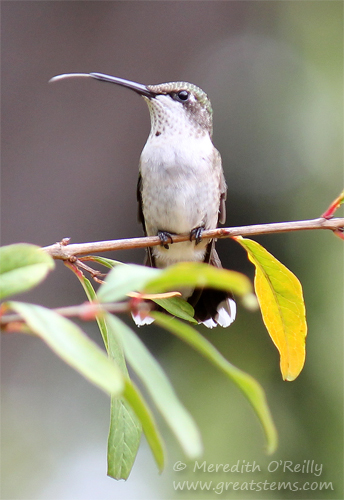
Most of the time I use my zoom lens with hummingbirds, because it enables me to get shots like this lucky tongue image.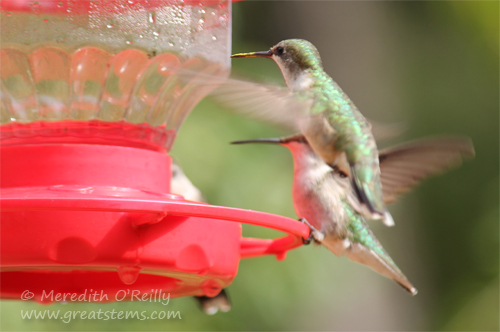
I also can capture pollen on a hummingbird’s bill. If you ever wondered whether a hummingbird is an effective pollinator, there’s proof.
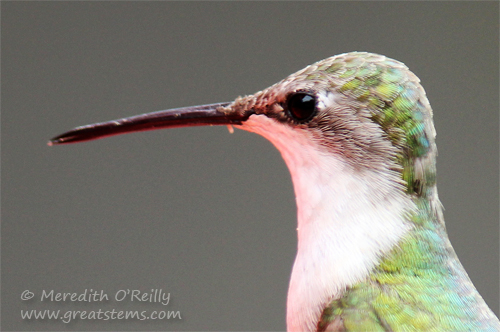
With the zoom, I can also get close enough to get feather details on the little birds and yet not disturb them.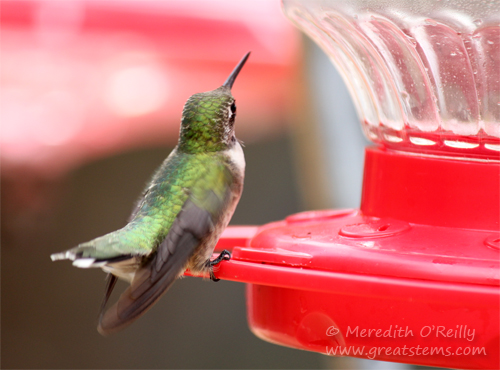
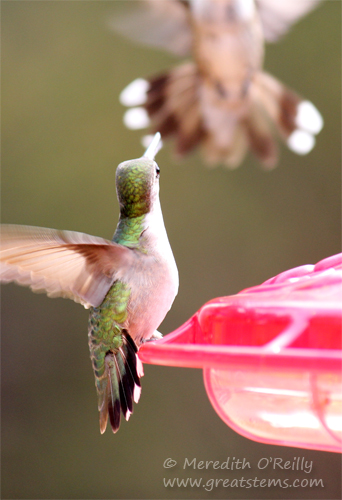
The downside to the zoom is that it gets tougher to capture the interaction between birds (when they really get their speed going). But it’s doable.
Today, however, brought a most enjoyable experience, all thanks to an annoying tilt of the shepherd’s hook holding two of our feeders. I couldn’t resist trying to fix it during a momentary lull in hummingbird activity. I had scarcely put my hand on the shepherd’s hook when suddenly I was surrounded by fast-moving, buzzing hummingbirds. There I was, inches from two feeders, and birds were swarming me. At first they circled me, periodically hovering in front of my face to see whether I was friend or foe, and since I didn’t move a muscle (other than to softly talk to them), they decided I was friend, or at least safe enough. Just inches from my face, they sat, drank, hovered, checked me out, drank some more, and even had their usual feisty spats. The breeze from their wings felt great upon my skin, and it was impressive how much air movement there was.
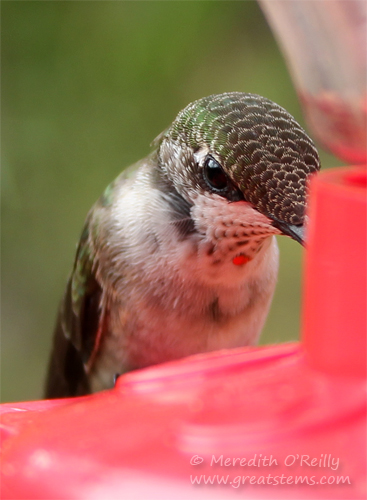
During another lull of activity, I quickly went inside to grab a regular lens, hoping to get a picture (the zoom wouldn’t have worked that close to my subjects). But I soon learned that while the hummingbirds did not mind me, they were less fond of my camera. Perhaps the lens looked like a large gaping mouth. Whichever feeder my face was near, the birds sat and drank without concern. Whichever feeder my camera faced, the birds were hesitant to linger at the feeder, and only a couple did fly-by drinking. Needless to say, it was a challenge to actually take a picture with a hummingbird in it, but I managed a couple. The above is my favorite.
Of course, once I realized how unperturbed the hummingbirds were by my presence, I encouraged my family to experience the thrill of being so close to the zooming birds. I can report that the hummingbirds did not mind Nolan’s small point-and-shoot camera. I think the “big lens = big mouth” theory might be close to the truth.
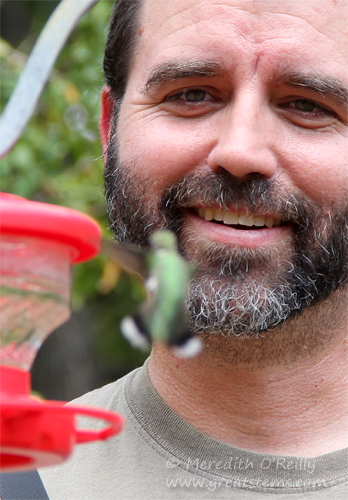
If you have visiting hummingbirds, especially in large numbers, I highly recommend you give it a try. Perhaps you’ll get to experience those lovely hummingbird breezes on your skin, too.
While helping with the fall 2013 Habitat Stewards class today at Hornsby Bend, I stopped to admire the construction and predatory skills of a few beautiful spiders who had picked prime flying-insect-rich real estate in which to build their giant webs.
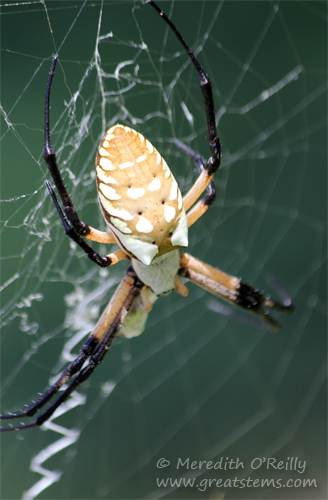
Argiope aurantia, known as the common garden spider, is generally a large yellow and black spider, though of course it can have color variations as you see above. Its big web can easily be two feet across, not including the framework. While Argiopes are generally considered solitary spiders, the insect activity in the area was enough to keep several of the spiders in close proximity. Danger, insects, danger!
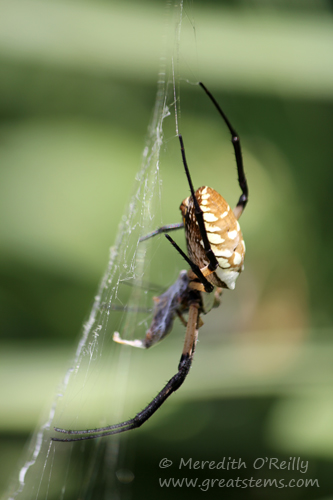
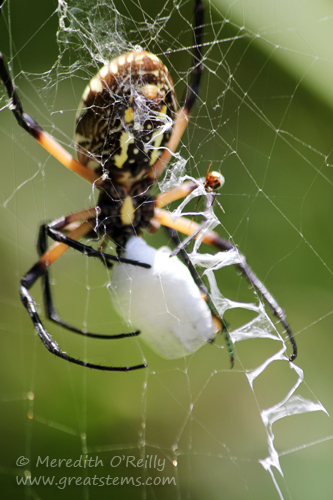 The garden spiders are sometimes called Writing Spiders because of the zig-zagged stabilimenta they create in the center of their webs.
The garden spiders are sometimes called Writing Spiders because of the zig-zagged stabilimenta they create in the center of their webs.
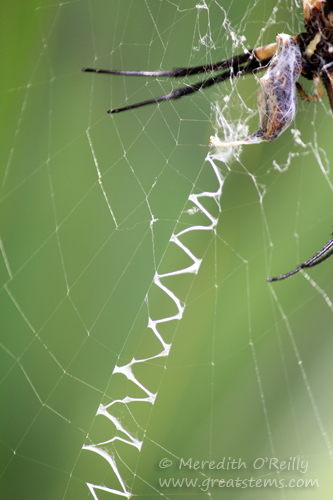 Here’s a better view of the stabilimentum of one of the Argiope aurantia. There are many theories about why some diurnal orbweaver spiders create such features in their webs, but it would seem that the stability theory for which the stabilimentum got its name has been disputed. It’s possible, though, that it has something to do with visibility, mating, predator avoidance, or attracting prey.
Here’s a better view of the stabilimentum of one of the Argiope aurantia. There are many theories about why some diurnal orbweaver spiders create such features in their webs, but it would seem that the stability theory for which the stabilimentum got its name has been disputed. It’s possible, though, that it has something to do with visibility, mating, predator avoidance, or attracting prey. 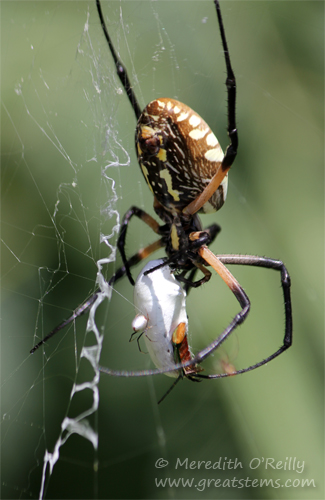
But the real story today isn’t about the gorgeous garden spiders, which normally would have me oohing and aahing. Okay, I’m still oohing and aahing, but what I really mean to talk about is the fact that a big orbweaver such as Argiope aurantia isn’t always the only spider in its web. In the above photo, a tiny dewdrop spider (Argyrodes elevatus) is sharing the meal of the larger spider.
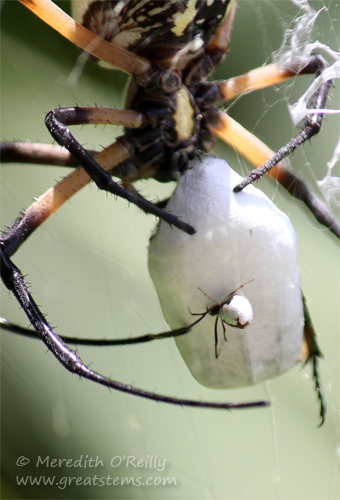
If you know how big garden spiders can get, then you should have an idea about just how much smaller the little dewdrop spider is. Yet there it is, bravely coming in to get some of food caught by the bigger spider. Dewdrop spiders, by the way, are members of the cobweb-weaver family. Presumably they are capable of building their own web, but why bother if they can steal from another predator instead? Clever little spiderses.
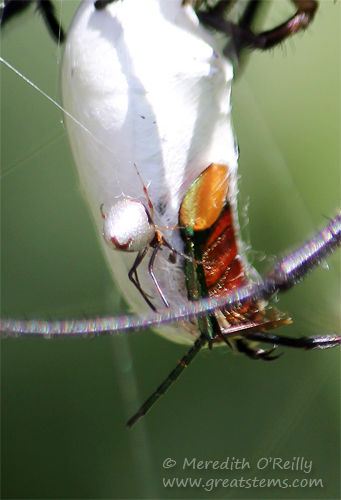
This behavior of stealing food is called kleptoparasitism. Cuckoo bees, seagulls, hyenas, and vultures — and our dogs — are some of the other animal species known to be kleptoparasitic, at least occasionally. In the case of our arachnid friends, sometimes a thieving spider will make a meal of tiny insects that get caught in the big web, and in doing so it helps keep the web clear without really affecting the Argiope spider. But when a nice big juicy bug gets caught and subsequently nabbed by the large garden spider, the little dewdrop spider will carefully approach the wrapped and pre-digested larger prey and secretly consume some of it, while making sure to avoid the attention of the big predator close by, lest it become a meal itself. Actually, some kleptoparasitic spiders have also been known to eat the host spider, but presumably the big spider has to die first.
Speaking of which, I watched a huge metallic beetle fly into another big web and got ready to take pictures of the sudden ambush from the orbweaver. But the orbweaver didn’t move, despite violent and desperate attempts of the beetle to escape the sticky web. I took a small twig and gently nudged the spider, and it didn’t move. I wonder why it died in the center of its web — very odd. No klepto spiders were eating it yet; perhaps they will, though, or maybe a bird will swoop it up if it can do so safely. Meanwhile, I used the twig to release the beetle, and it flew away to live another day… or at least a few more minutes until it zips into another silky deathtrap.
September is one of my favorite months, for the hummingbirds are moving through Texas in large numbers at this time, and it means my garden is busy with little bird antics left and right (and up and down).
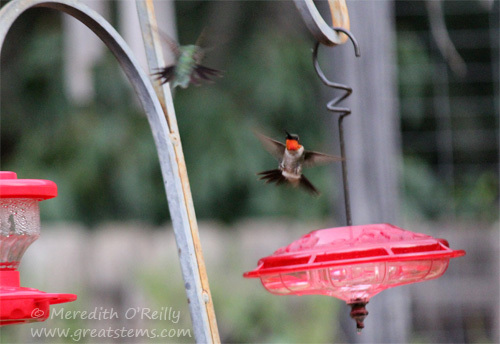 The sounds of the feisty little birds draw me outside. The hummingbirds are usually so focused on defense and territoriality and getting nectar that they hardly noticed the humans taking pictures, dogs running amok, and thunder or other noises in the background. Such was this evening’s setting.
The sounds of the feisty little birds draw me outside. The hummingbirds are usually so focused on defense and territoriality and getting nectar that they hardly noticed the humans taking pictures, dogs running amok, and thunder or other noises in the background. Such was this evening’s setting.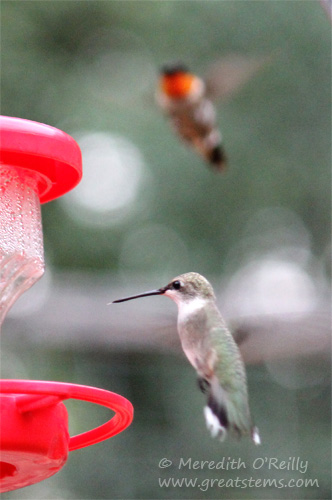
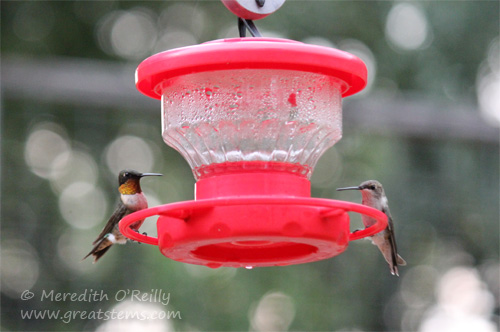 Occasionally hummingbirds will settle down and share a feeder. In fact, as more hummers appear during migration, they will share more and more, as the need to build up energy stores for long-distance travel becomes more pressing.
Occasionally hummingbirds will settle down and share a feeder. In fact, as more hummers appear during migration, they will share more and more, as the need to build up energy stores for long-distance travel becomes more pressing.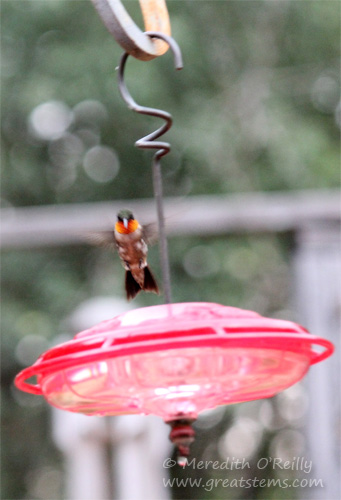 During migration season, the vast majority of the hummingbirds I see in my Austin garden are Ruby-throats. The males have the iridescent gorget, which seems truly vibrant when the light is just right (but otherwise it looks dark).
During migration season, the vast majority of the hummingbirds I see in my Austin garden are Ruby-throats. The males have the iridescent gorget, which seems truly vibrant when the light is just right (but otherwise it looks dark).
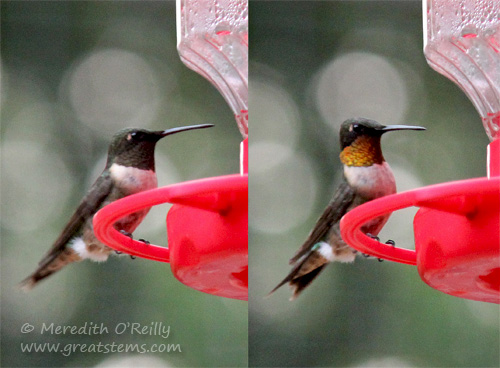
Because the male’s gorget often appears dark, Ruby-throats are often confused with Black-chinned hummers. But take a look at how this male’s feathers light up with just a slight change to its body position. The color you see is actually a function of feather structure and the refraction of light at particular angles and is not a result of pigmentation.
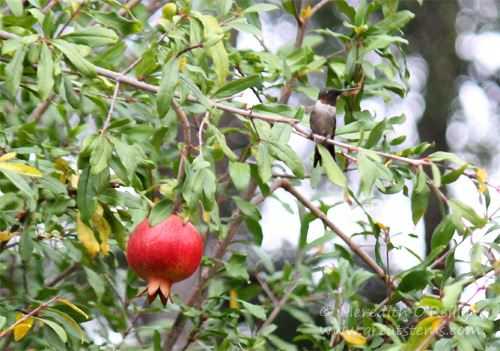
Don’t be fooled into thinking this hummingbird, almost hidden among the leaves, is remarkably big, given the pomegranate nearby as a size comparison. That’s actually a small pomegranate (the big pomegranates have weighed their respective branches down much closer to the ground, and no hummingbirds ever hang out down there).
Aside from the feeders, our backyard trees are territorial zones for many of the hummingbirds, who stake claim not just to particular trees but to very specific branches on said trees. The bird above was the only one using that spot on the Pomegranate — he drove away any other hummer that came too close. Likewise, the Mexican Redbuds were claimed by a few hummingbirds, likely because they were close to three feeders. The nearby Oak trees offered higher vantage points, so some hummingbirds used those instead.
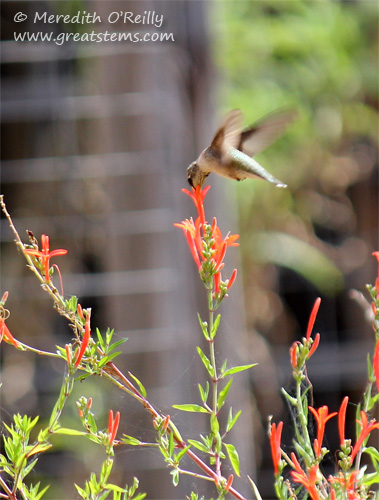
Of course, native plants offer the best nectar of all, but I always put out feeders during migration because it can be hit or miss whether any of my natives are blooming in the hot Texas summer. Often, I’m relying on my trusty Flame Acanthus to be in bloom while summer is still blazing. Indeed, my Flame Acanthus is blooming right now, but I’m cheating and showing a picture I took last year. And actually, fyi, I keep feeders up year round, though perhaps not as many in the winter. You never know when a slowpoke hummingbird will desperately be seeking food sources in the cold.
If you have feeders, be sure to use a ratio of 1 part Table Sugar to 4 parts water — don’t add coloring.
And always keep your feeders clean! Replace the sugar-water every 2-3 days to prevent fermentation, and use that opportunity to scrub out the feeders thoroughly. I use vinegar to clean mine (and small brushes). Don’t let any black yucky stuff build up in those nooks and crannies!
For those of you up north who are saying a seasonal goodbye to hummingbirds, thank you for taking good care of them. They’ll be back in the spring to say hello before you know it!
I went outside to take a picture of a lovely blooming and ever so drought-tolerant little shrub in the garden, only to discover that its blooms had come and gone. I’ll have to catch it on the next bloom cycle, because I love it so (it’s called a Pyramid Bush). But what did catch my eye were some of the objects decorating our fence, and I realized that I’d never actually posted about them.
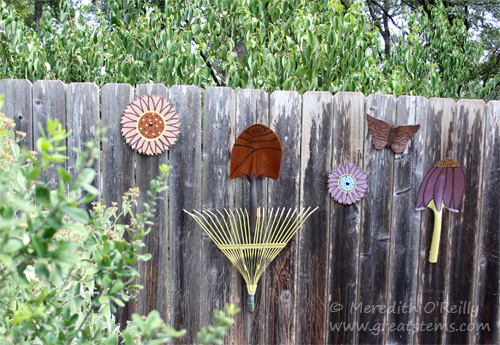
From time to time, tools break beyond repair, and I hate to see them go to waste. It’s amazing what a bit of paint can do.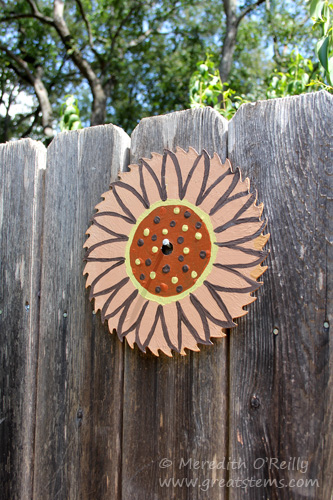
This saw blade isn’t technically a garden tool, but it certainly has helped build things for the garden. It makes a perfect flower.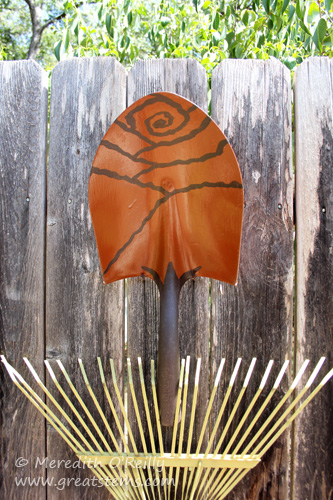 How about a shovel that becomes a rose, with a rake as the foliage? The rake is actually painted a light green, but in the sun it looks more yellow than lime, I admit. Someday, if I happen to have a different color of leftover paint, I might paint over it, but part of this endeavor is utilizing what I have at home, not going out and buying something.
How about a shovel that becomes a rose, with a rake as the foliage? The rake is actually painted a light green, but in the sun it looks more yellow than lime, I admit. Someday, if I happen to have a different color of leftover paint, I might paint over it, but part of this endeavor is utilizing what I have at home, not going out and buying something. 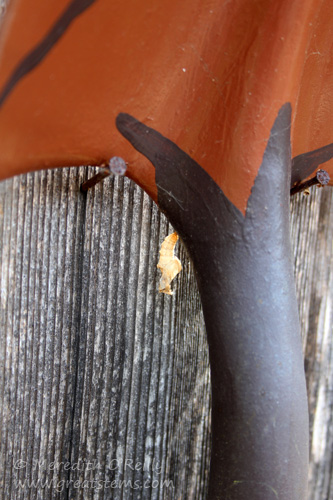
Look what I found behind the rose shovel — a spent Gulf Fritillary chrysalis. That little caterpillar crawled a long way across the garden to become a butterfly!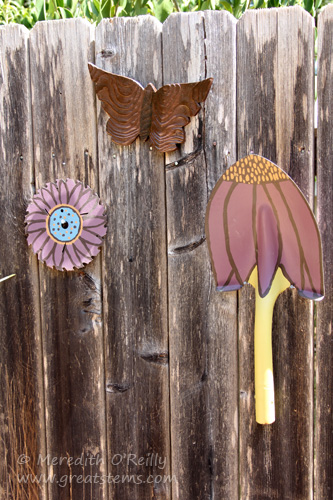 A smaller sawblade gave an opportunity for another bloom, and a second shovel blade became a Purple Coneflower. The coneflower might be my favorite of the tool bouquet, honestly. The butterfly isn’t a leftover tool, obviously, but a gift from sweet friends.
A smaller sawblade gave an opportunity for another bloom, and a second shovel blade became a Purple Coneflower. The coneflower might be my favorite of the tool bouquet, honestly. The butterfly isn’t a leftover tool, obviously, but a gift from sweet friends.
Some day I might paint some stems on the fence to complete all the flowers. I had saved a broken garden hose to be the stems, but the pieces are more complicated to hang and I just haven’t been inspired yet to do so.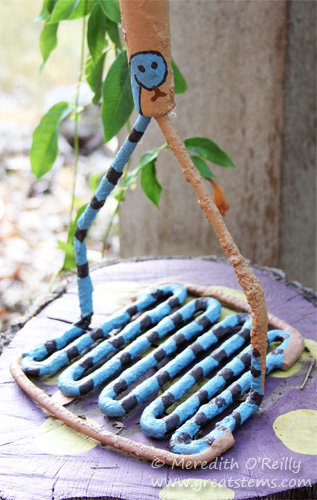
A little too awkward to hang on the fence, this tool gets its own stand. The broken mud masher, formerly used to mix cement, inspired a serpentine theme. By the way, it’s sitting on a painted log — we have a few such logs in different colors around the backyard woodlands, and they add a nice touch of color here and there.
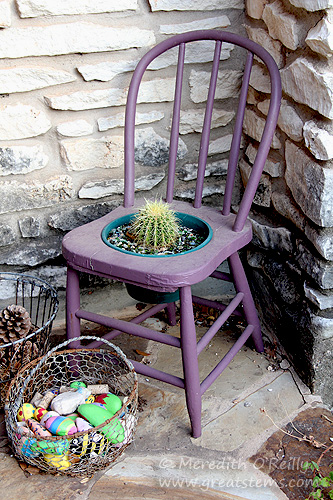
Though this painted old chair (I’ve always called it a potty chair, but I don’t know if that’s really what it once was) isn’t exactly a former tool and nor is it broken, I thought I should include it with the group of colorful, re-purposed objects around the garden. I painted it a few years ago and added a Golden Barrel Cactus for mischievous fun. Just don’t sit on it!
Got any fun ways you give broken tools a new life?